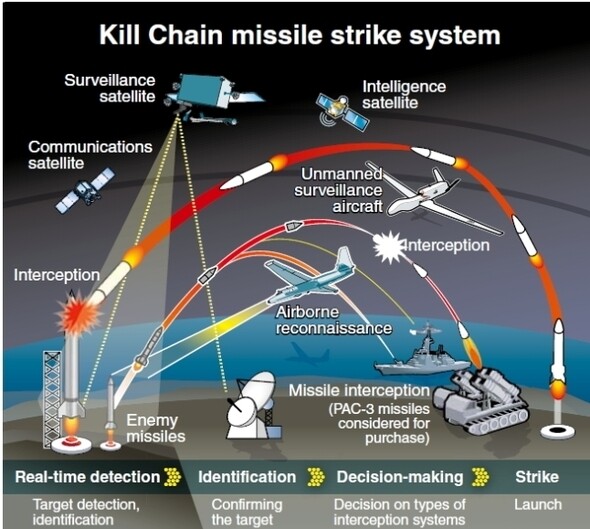hankyoreh
Links to other country sites 다른 나라 사이트 링크
S. Korean military speeds up development of Kill Chain and other response capabilities

The South Korean military recently decided to move up development of military response capabilities for the North Korean nuclear and missile threats to the early 2020s.
The measures were included in a 2018-2022 Mid-Term National Defense Plan released on Apr. 11 by the Ministry of National Defense. The plans, which serve as blueprints for construction and operation of military strength over the following five years, are announced on an annual basis.
Most notably, the ministry plans to move up the schedule for building what it bills as a “Korean-model three-axis system” to respond to North Korea’s nuclear and missile programs from the mid-2020s to the early 2020s. The system refers to three types of military measures: a Kill Chain” for a preemptive strike in response to signs of an imminent North Korean missile or nuclear weapon attack, a Korean Air and Missile Defense (KAMD) system to intercept North Korean missiles, and a Korean Massive Punishment and Retaliation (KMPR) system for retaliating directly against the North Korean leadership in the event of a nuclear attack.
For the Kill Chain, the military plans to rent four to five intelligence satellites from overseas to monitor North Korea. The rentals are to take place for a limited time until development and operation of South Korea’s own intelligence satellites in the early 2020s. The military also plans to introduce or obtain new guided bombs, Hyunmoo-2 ballistic missiles, Hyunmoo-3 cruise missiles, and Taurus air-to-ground missiles to strike against North Korean nuclear and missile facilities.
For KAMD, it plans to acquire new Patriot Advanced Capability-3 missiles and hasten performance improvements in its medium-range surface-to-air missile (M-SAM) system. For KMPR, it plans to improve the capabilities of UH-60 and UH-47D helicopters for special forces entering enemy lines and acquire unmanned reconnaissance drones for special operations.
By Park Byong-su, senior staff writer
Please direct questions or comments to [english@hani.co.kr]

Editorial・opinion
![[Editorial] Intensifying US-China rivalry means Seoul must address uncertainty with Beijing sooner than later [Editorial] Intensifying US-China rivalry means Seoul must address uncertainty with Beijing sooner than later](https://flexible.img.hani.co.kr/flexible/normal/500/300/imgdb/original/2024/0517/8117159322045222.jpg) [Editorial] Intensifying US-China rivalry means Seoul must address uncertainty with Beijing sooner than later
[Editorial] Intensifying US-China rivalry means Seoul must address uncertainty with Beijing sooner than later![[Column] When ‘fairness’ means hate and violence [Column] When ‘fairness’ means hate and violence](https://flexible.img.hani.co.kr/flexible/normal/500/300/imgdb/original/2024/0516/7417158465908824.jpg) [Column] When ‘fairness’ means hate and violence
[Column] When ‘fairness’ means hate and violence- [Editorial] Yoon must stop abusing authority to shield himself from investigation
- [Column] US troop withdrawal from Korea could be the Acheson Line all over
- [Column] How to win back readers who’ve turned to YouTube for news
- [Column] Welcome to the president’s pity party
- [Editorial] Korea must respond firmly to Japan’s attempt to usurp Line
- [Editorial] Transfers of prosecutors investigating Korea’s first lady send chilling message
- [Column] Will Seoul’s ties with Moscow really recover on their own?
- [Column] Samsung’s ‘lost decade’ and Lee Jae-yong’s mismatched chopsticks
Most viewed articles
- 1For new generation of Chinese artists, discontent is disobedience
- 2[Column] US troop withdrawal from Korea could be the Acheson Line all over
- 3[Editorial] Intensifying US-China rivalry means Seoul must address uncertainty with Beijing sooner t
- 4[Exclusive] Unearthed memo suggests Gwangju Uprising missing may have been cremated
- 5China calls US tariffs ‘madness,’ warns of full-on trade conflict
- 6[Editorial] Transfers of prosecutors investigating Korea’s first lady send chilling message
- 7Xi, Putin ‘oppose acts of military intimidation’ against N. Korea by US in joint statement
- 8[Column] When ‘fairness’ means hate and violence
- 9Another chaebol heir caught smuggling liquid marijuana into South Korea
- 10For Korea’s Justice Ministry, no place is sacred from immigration raids